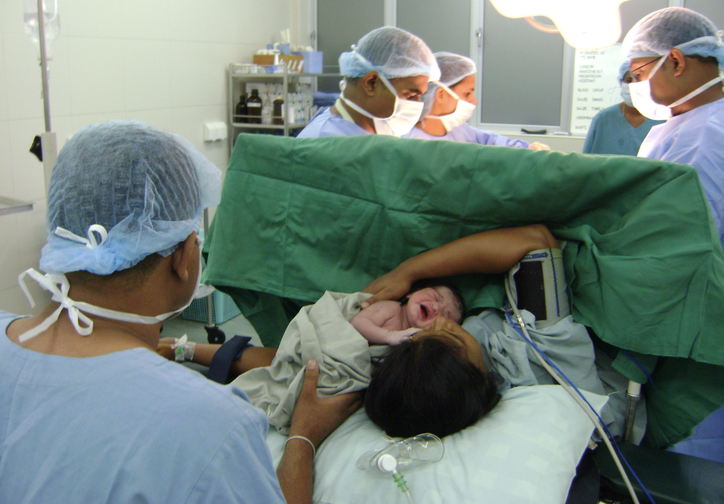
COVID-19 shows how dangerous it is to neglect midwives and community care
Diverse forms of healthcare services allow for adaptation – essential in a crisis – so we must reinstate and reinvest in community-based models of care

More than a year after the start of the global coronavirus pandemic, and the release of openDemocracy’s investigation into childbirth during COVID-19, we know that there have been too many violations of women’s pregnancy and childbirth rights during this crisis, including outright suspensions of services.
Too often, the response of governments and health facilities to the spreading pandemic quickly abandoned evidence-based, respectful care practices, without adequately considering alternatives – including via midwives and community-based care models – that could enhance infection prevention while also protecting such practices.
But there is also good news. Around the world, women, healthcare providers and (some) decision makers have imagined and implemented solutions in response to these problems. These innovations, crafted in a time of crisis, hold very valuable lessons.
At the level of healthcare providers and facilities, damaging top-down changes that suspended rights and services were mitigated in some contexts by rapid adaptations to uphold respectful care in the face of COVID-19 challenges.
In Croatia, for example, staff at the small Čakovec General Hospital – which serves a population north of the capital Zagreb with a high proportion of Roma women – resisted banning birth companions at a time when 90% of the country’s hospitals did so. Instead, they decided to procure COVID-19 rapid antigen tests for both the expectant mother and her companion, to ensure that women could have birth companions and remain with their babies at all times – a correct and best practice for optimal health outcomes.
In the Netherlands and in Mexico, midwives used hotels and newly established ‘maternity homes’, respectively, for birth and postpartum care for healthy women with low-risk pregnancies. This minimised their exposure to COVID-19 and also ensured their autonomy during birth.
Digital and telehealth alternatives enabled women to talk to doctors and other healthcare professionals via virtual consultations (UK), and facilitated self-care through YouTube videos (Japan) and online group birth preparation classes (mostly in high-income countries).
However, this shift to online methods also exacerbated inequalities. One doctor in India noted that “the use of the phone, SMS and WhatsApp is a success for telemedicine, but only 30% of the people have a smartphone.”
For women facing intersecting barriers to accessing healthcare, it was community-based health workers, especially midwives, who stepped in and stepped up.
In Mexico, groups of midwives in the states of Chiapas, San Luis Potosí and Oaxaca coordinated ‘care brigades’ to visit women in remote, predominantly Indigenous communities. In Alaska, Indigenous women have approved the return to traditional practices of being supported by a midwife to give birth at home, where they can speak their native language and have family nearby. Before the pandemic, they were often encouraged – or even required – to travel hundreds of miles south to give birth.
In Croatia, Slavojka Aresnović, a midwife working on the island of Korčula, accompanied pregnant and birthing women on their precarious 100-kilometre ambulance journey over bumpy roads to the nearest hospital – which is in Dubrovnik on the mainland.
Community-based maternity care
With COVID-19 far from over and growing disparities and inequities in health outcomes around the world, what can we learn from the solutions crafted during the pandemic about restructuring and improving the ways that maternity care is delivered?
Countries around the world have long abandoned community midwifery services in favour of centralised care, but the pandemic has shown how dangerous it is to rely on a single form of care delivery during emergencies. It is past time to reinstate community-based models of care, including community midwifery services. Diversity in the who, where and how of healthcare delivery allows for adaptation during crises.
Midwifery must be an integrated part of a country’s health system and pandemic readiness
Midwives are often part of the community and therefore can be the last health professionals left standing to provide care during crises. Throughout the pandemic, midwives continued to provide culturally sensitive care, while also supporting autonomy and choice for women even as COVID-19 stoked fear and uncertainty.
But midwives and community health workers need support to provide this critical care. As a first step, midwifery must be financed as an integrated part of a country’s health system and pandemic readiness. Ensuring that midwives are involved when essential public health policy and funding decisions are being made is also critical to building – and sustaining – equitable and women-centred models of care.
Right now, forthcoming post-crisis austerity measures threaten further cuts to maternal and reproductive health, and especially to community services, despite evidence that expanding midwifery services is a cost-effective model. In Mexico, pandemic-related austerity measures are already depriving existing traditional midwives and dedicated Indigenous women’s centres of essential federal funding.
As we manage the ongoing evolution of the pandemic amid inequitable vaccine rollouts, as well as the inevitable conflict and climate disasters of the future, we must not be complacent about violations of women’s and newborn rights – but we must also do more than simply fix what has failed over the past year.
What women want are birth experiences and sexual and reproductive healthcare services that are centred on respect and dignity, where health professionals are supported to deliver that care.
In the most precarious situations, it is community-based healthcare models, especially midwifery services, that uphold human rights and respectful, accessible and, ultimately, safe care for women and their families. As countries around the world ebb and flow toward reopening and rebuilding, it is time to reimagine and reinvest in models of care that we know and have seen work during COVID-19 and beyond.
Read more
Get our weekly email




Comments
We encourage anyone to comment, please consult the oD commenting guidelines if you have any questions.